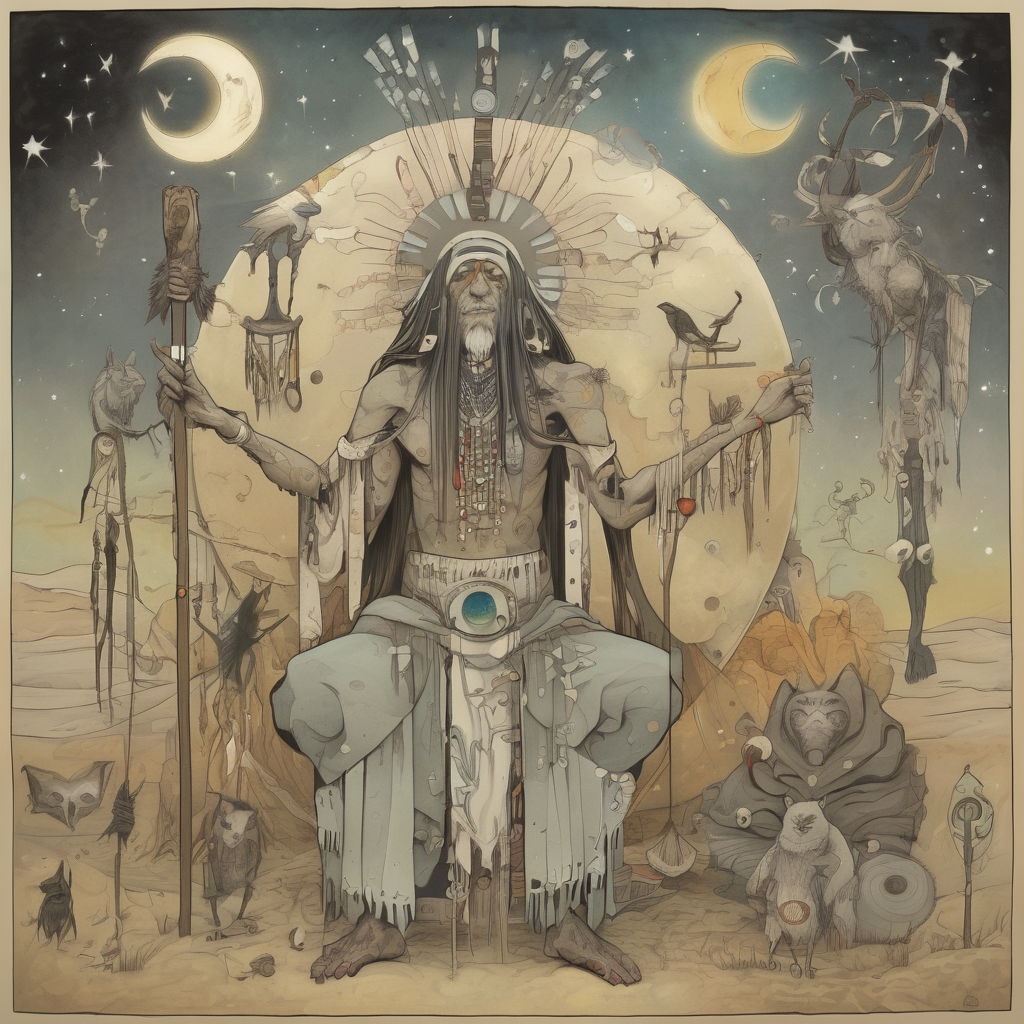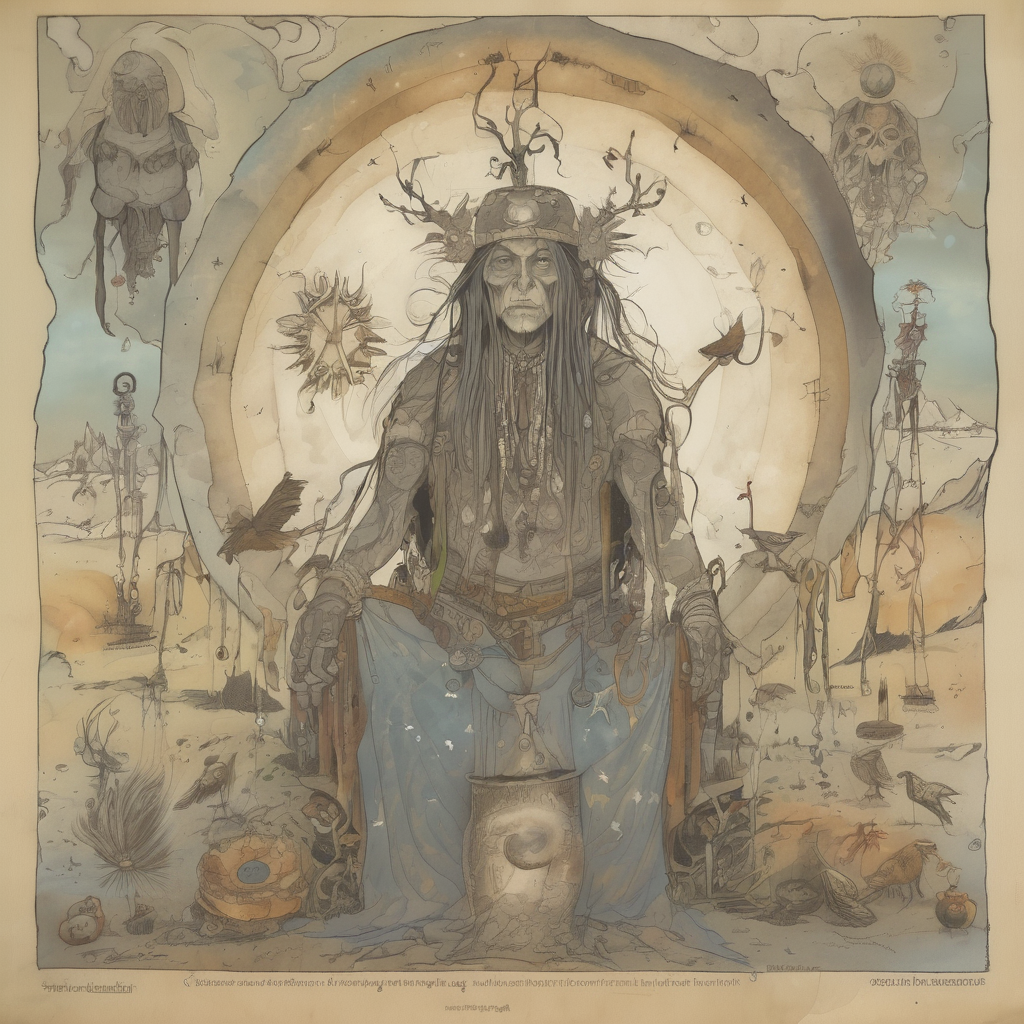Shamanic & Indigenous Cosmologies

Astrotheology is the study of the relationship between celestial objects, such as the sun, moon, stars, and planets, and religious or spiritual beliefs. Many ancient cultures, such as the ancient Egyptians, Mesopotamians, and Greeks, developed sophisticated astrological systems and incorporated celestial phenomena into their religious and mythological worldviews. In astrotheology, the movements and patterns of the heavenly bodies are often seen as representations of divine or supernatural forces, and the study of the stars and planets is believed to provide insights into the nature of the universe and the human condition.
Throughout history, as human civilizations have developed and evolved, the movements and patterns of the sun, moon, stars, and planets have played a central role in shaping their cosmological and theological worldviews. One particularly fascinating aspect is the way in which different cultures have interpreted and imbued celestial bodies and phenomena with profound symbolic and spiritual significance.
Stellar deities and constellations:
Many cultures have personified and deified the stars and constellations, seeing them as powerful celestial entities or manifestations of their gods and goddesses. For instance, in ancient Mesopotamian religions, the god Marduk was associated with the planet Jupiter, while the goddess Ishtar was linked to the planet Venus. Similarly, in ancient Greek mythology, the constellations were seen as representations of mythological figures and stories.
Planetary archetypes:
Across belief systems, the visible planets have often been ascribed distinct symbolic and archetypal qualities. For example, the Sun is frequently associated with themes of divine kingship, vitality, and masculine energy, while the Moon is linked to the feminine, the cycles of nature, and intuition. Mars, the god of war, is often seen as representing aggression and conflict, while Jupiter, the king of the gods, embodies concepts of expansion, wisdom, and leadership.
Celestial cycles and the sacred calendar:
The observation of the cyclical movements of the sun, moon, and planets has been integral to the development of sacred calendars and the timing of religious festivals and rituals in many cultures. For instance, the Mayan calendar system was intricately tied to the alignments of celestial bodies, and their religious practices were closely synchronized with these cosmic rhythms.
Shamanic and indigenous cosmologies:
Many shamanic and indigenous belief systems have deep connections to celestial phenomena. For example, in some Native American traditions, the stars and constellations are seen as portals to the spirit world, with celestial events and alignments playing a crucial role in divination and spiritual practices.
Esoteric and occult traditions:
Throughout history, various esoteric and occult belief systems, such as Hermeticism, Neoplatonism, and Hermetic Qabalah, have explored the mystical and symbolic connections between the heavens and the human experience, often incorporating astrological and alchemical concepts into their cosmologies and spiritual practices.
In these belief systems, the night sky is often seen as a veil or membrane that separates the physical world from the realm of spirits, ancestors, and other non-physical entities. The stars and constellations are believed to be openings or "holes" in this celestial veil, through which shamans, medicine people, and other spiritual practitioners can access the spirit world.
Here are some examples of how this celestial cosmology is expressed in various Native American traditions:
Ojibwe (Anishinaabe) tradition:
The Ojibwe people of the Great Lakes region believe that the Milky Way galaxy is a "spirit road" that connects the Earth to the sky world. They see the stars as the campfires of their ancestral spirits, who reside in the celestial realm.
Navajo (Diné) tradition:
In Navajo cosmology, the stars are considered to be openings in the sky, through which the Holy People (deities) can descend to the mortal world. Certain constellations, like the Big Dipper, are seen as sacred guides and doorways to the spirit realm.
Lakota tradition:
The Lakota people of the Great Plains region believe that the stars are the homes of their ancestral spirits and powerful spiritual beings. They associate specific constellations, like the Pleiades, with the locations of important ceremonial sites and ritual knowledge.
Hopi tradition:
The Hopi of the Southwestern United States view the heavens as a metaphorical "Great House," with the Sun, Moon, and planets serving as the celestial inhabitants. They believe that during certain celestial events, like eclipses, the veil between the physical and spiritual worlds becomes thinner, allowing for increased communication and interaction.

Celestial Ceremonies and Rituals:
Many Native American tribes incorporate intricate ceremonial practices that are directly tied to the movements and alignments of the sun, moon, stars, and planets. For example, the Hopi New Year ceremony is precisely timed to coincide with the winter solstice, while the Lakota Sun Dance is linked to the summer solstice. These rituals often involve chanting, dancing, and the making of offerings to the celestial spirits.
Celestial Symbols and Iconography:
The imagery of the night sky is extensively represented in the art, symbols, and iconography of numerous Native American cultures. Motifs like the Thunderbird (associated with the constellation Orion), the Spider Woman (linked to the Pleiades), and the Milky Way as the "Path of Souls" are common themes found in their visual traditions, textiles, and rock art.
Celestial Navigation and Wayfinding:
Many indigenous tribes utilized their keen observations of the stars and celestial patterns to navigate vast landscapes and seascapes. For instance, the Inuit people of the Arctic regions used the positions of the stars to guide their travel across the tundra and sea ice, while the Polynesian voyagers relied on celestial navigation to traverse the open ocean.
Throughout these diverse traditions, the stars, planets, and other celestial phenomena are seen as living, sentient beings that play a vital role in the spiritual and practical lives of indigenous peoples. The ability to read and interpret the messages of the cosmos is highly revered, as it provides a means of connecting with the ancestral spirits and the greater universal forces that shape the human experience.
Comments
Post a Comment